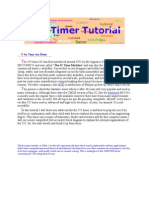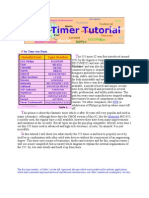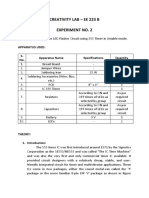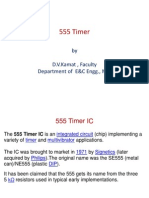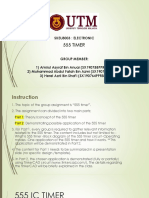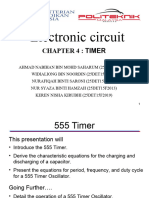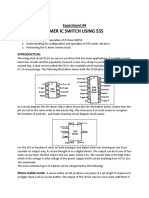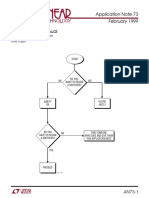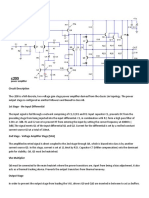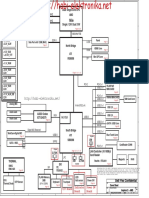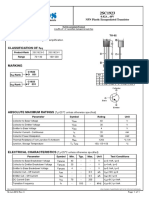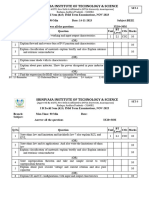Oscillator Tutorial
Uploaded by
yt2005Oscillator Tutorial
Uploaded by
yt2005555 Timer/Oscillator Tutorial
Este documento ha sido elaborado con PDFmail Página
(Copyright RTE Software) 1 de 32
http://www.pdfmail.com
© by Tony van Roon
Thank you Ron Harrison from Micron Technology, Inc. for pointing out
the errors in this tutorial!
The 555 timer IC was first introduced arround 1971 by the Signetics
Corporation as the SE555/NE555 and was called "The IC Time
Machine" and was also the very first and only commercial timer ic
available. It provided circuit designers and hobby tinkerers with a
relatively cheap, stable, and user-friendly integrated circuit for both
monostable and astable applications. Since this device was first made
commercially available, a myrad of novel and unique circuits have been
developed and presented in several trade, professional, and hobby
publications. The past ten years some manufacturers stopped making
these timers because of competition or other reasons. Yet other
companies, like NTE (a subdivision of Philips) picked up where some
left off.
This primer is about this fantastic timer which is after 30 years still
very popular and used in many schematics. Although these days the
CMOS version of this IC, like the Motorola MC1455, is mostly used, the
regular type is still available, however there have been many
improvements and variations in the circuitry. But all types are pin-for-
pin plug compatible. Myself, every time I see this 555 timer used in
advanced and high-tech electronic circuits, I'm amazed. It is just
incredible.
In this tutorial I will show you what exactly the 555 timer is and how
to properly use it by itself or in combination with other solid state
devices without the requirement of an engineering degree. This timer
uses a maze of transistors, diodes and resistors and for this complex
reason I will use a more simplified (but accurate) block diagram to
file://C:\tmp\555 Timer-Oscillator Tutorial.htm 27-05-02
555 Timer/Oscillator Tutorial
Este documento ha sido elaborado con PDFmail Página
(Copyright RTE Software) 2 de 32
http://www.pdfmail.com
explain the internal organizations of the 555. So, lets start slowly and
build it up from there.
The first type-number, in Table 1 on the
left, represents the type which was/is
preferred for military applications which
have somewhat improved electrical and
thermal characteristics over their
commercial counterparts, but also a bit
more expensive, and usually metal-can or
ceramic casing. This is analogous to the
5400/7400 series convention for TTL integrated circuits.
The 555, in fig. 1 and fig. 2 above, come in two packages, either the
round metal-can called the 'T' package or the more familiar 8-pin DIP 'V'
package. About 20-years ago the metal-can type was pretty much the
standard (SE/NE types). The 556 timer is a dual 555 version and comes
in a 14-pin DIP package, the 558 is a quad version with four 555's also
file://C:\tmp\555 Timer-Oscillator Tutorial.htm 27-05-02
555 Timer/Oscillator Tutorial
Este documento ha sido elaborado con PDFmail Página
(Copyright RTE Software) 3 de 32
http://www.pdfmail.com
in a 14 pin DIP case.
I nside the 555
timer, at fig. 3, are
the equivalent of
over 20 transistors,
15 resistors, and 2
diodes, depending
of the
manufacturer. The
equivalent circuit,
in block diagram,
providing the
functions of
control, triggering,
level sensing or
comparison,
discharge, and
power output.
Some of the more attractive features of the 555 timer are: Supply voltage between
4.5 and 18 volt, supply current 3 to 6 mA, and a Rise/Fall time of 100 nSec. It can
also withstand quite a bit of abuse.
The Threshold current determine the maximum value of Ra + Rb. For 15 volt
operation the maximum total resistance for R (Ra +Rb) is 20 Mega-ohm.
The supply current, when the output is 'high', is typically 1 milli-amp
(mA) or less. The initial monostable timing accuracy is typically within
1% of its calculated value, and exhibits negligble (0.1%/V) drift with
supply voltage. Thus longterm supply variations can be ignored, and the
temperature variation is only 50ppm/°C (0.005%/°C).
All IC timers rely upon an
external capacitor to determine
file://C:\tmp\555 Timer-Oscillator Tutorial.htm 27-05-02
555 Timer/Oscillator Tutorial
Este documento ha sido elaborado con PDFmail Página
(Copyright RTE Software) 4 de 32
http://www.pdfmail.com
external capacitor to determine
the off-on time intervals of the
output pulses. As you recall
from your study of basic
electronics, it takes a finite
period of time for a capacitor
(C) to charge or discharge
through a resistor (R). Those
times are clearly defined and
can be calculated given the
values of resistance and
capacitance.
The basic RC charging circuit
is shown in fig. 4. Assume that the capacitor is initially discharged.
When the switch is closed, the capacitor begins to charge through the
resistor. The voltage across the capacitor rises from zero up to the value
of the applied DC voltage. The charge curve for the circuit is shown in
fig. 6. The time that it takes for the capacitor to charge to 63.7% of the
applied voltage is known as the time constant (t). That time can be
calculated with the simple expression:
t=RXC
Assume a resistor value of 1 MegaOhm and a capacitor value of 1uF
(micro-Farad). The time constant in that case is:
t = 1,000,000 X 0.000001 = 1 second
Assume further that the applied voltage is 6 volts. That means that it
will take one time constant for the voltage across the capacitor to reach
63.2% of the applied voltage. Therefore, the capacitor charges to
approximately 3.8 volts in one second.
Fig. 4-1, Change in the input pulse
frequency allows completion of the
timing cycle. As a general rule, the
monostable 'ON' time is set
approximately 1/3 longer than the
file://C:\tmp\555 Timer-Oscillator Tutorial.htm 27-05-02
555 Timer/Oscillator Tutorial
Este documento ha sido elaborado con PDFmail Página
(Copyright RTE Software) 5 de 32
http://www.pdfmail.com
approximately 1/3 longer than the
expected time between triggering
pulses. Such a circuit is also known as a 'Missing Pulse Detector'.
Looking at the curve in fig. 6. you can see that it takes approximately
5 complete time constants for the capacitor to charge to amost the
applied voltage. It would take about 5 seconds for the voltage on the
capacitor to rise to approximately the full 6-volts.
Definition of Pin Functions:
Refer to the internal 555 schematic of Fig. 4-2
Pin 1 (Ground): The ground (or common) pin is the most-negative
supply potential of the device, which is normally connected to circuit
common (ground) when operated from positive supply voltages.
file://C:\tmp\555 Timer-Oscillator Tutorial.htm 27-05-02
555 Timer/Oscillator Tutorial
Este documento ha sido elaborado con PDFmail Página
(Copyright RTE Software) 6 de 32
http://www.pdfmail.com
Pin 2 (Trigger): This pin is the input to the lower comparator and is
used to set the latch, which in turn causes the output to go high. This is
the beginning of the timing sequence in monostable operation.
Triggering is accomplished by taking the pin from above to below a
voltage level of 1/3 V+ (or, in general, one-half the voltage appearing at
pin 5). The action of the trigger input is level-sensitive, allowing slow
rate-of-change waveforms, as well as pulses, to be used as trigger
sources. The trigger pulse must be of shorter duration than the time
interval determined by the external R and C. If this pin is held low longer
than that, the output will remain high until the trigger input is driven
high again. One precaution that should be observed with the trigger input
signal is that it must not remain lower than 1/3 V+ for a period of time
longer than the timing cycle. If this is allowed to happen, the timer will
retrigger itself upon termination of the first output pulse. Thus, when the
timer is driven in the monostable mode with input pulses longer than the
desired output pulse width, the input trigger should effectively be
shortened by differentiation. The minimum-allowable pulse width for
triggering is somewhat dependent upon pulse level, but in general if it is
greater than the 1uS (micro-Second), triggering will be reliable. A
second precaution with respect to the trigger input concerns storage time
in the lower comparator. This portion of the circuit can exhibit normal
turn-off delays of several microseconds after triggering; that is, the latch
can still have a trigger input for this period of time after the trigger
pulse. In practice, this means the minimum monostable output pulse
width should be in the order of 10uS to prevent possible double
triggering due to this effect. The voltage range that can safely be applied
to the trigger pin is between V+ and ground. A dc current, termed the
trigger current, must also flow from this terminal into the external
circuit. This current is typically 500nA (nano-amp) and will define the
upper limit of resistance allowable from pin 2 to ground. For an astable
configuration operating at V+ = 5 volts, this resistance is 3 Mega-ohm; it
can be greater for higher V+ levels.
Pin 3 (Output): The output of the 555 comes from a high-current
totem-pole stage made up of transistors Q20 - Q24. Transistors Q21 and
Q22 provide drive for source-type loads, and their Darlington connection
provides a high-state output voltage about 1.7 volts less than the V+
supply level used. Transistor Q24 provides current-sinking capability for
low-state loads referred to V+ (such as typical TTL inputs). Transistor
Q24 has a low saturation voltage, which allows it to interface directly,
file://C:\tmp\555 Timer-Oscillator Tutorial.htm 27-05-02
555 Timer/Oscillator Tutorial
Este documento ha sido elaborado con PDFmail Página
(Copyright RTE Software) 7 de 32
http://www.pdfmail.com
with good noise margin, when driving current-sinking logic. Exact
output saturation levels vary markedly with supply voltage, however, for
both high and low states. At a V+ of 5 volts, for instance, the low state
Vce(sat) is typically 0.25 volts at 5 mA. Operating at 15 volts, however,
it can sink 200mA if an output-low voltage level of 2 volts is allowable
(power dissipation should be considered in such a case, of course). High-
state level is typically 3.3 volts at V+ = 5 volts; 13.3 volts at V+ = 15
volts. Both the rise and fall times of the output waveform are quite fast,
typical switching times being 100nS. The state of the output pin will
always reflect the inverse of the logic state of the latch, and this fact may
be seen by examining Fig. 3. Since the latch itself is not directly
accessible, this relationship may be best explained in terms of latch-input
trigger conditions. To trigger the output to a high condition, the trigger
input is momentarily taken from a higher to a lower level. [see "Pin 2 -
Trigger"]. This causes the latch to be set and the output to go high.
Actuation of the lower comparator is the only manner in which the
output can be placed in the high state. The output can be returned to a
low state by causing the threshold to go from a lower to a higher level
[see "Pin 6 - Threshold"], which resets the latch. The output can also be
made to go low by taking the reset to a low state near ground [see "Pin 4
- Reset"]. The output voltage available at this pin is approximately equal
to the Vcc applied to pin 8 minus 1.7V.
Pin 4 (Reset): This pin is also used to reset the latch and return the
ouput to a low state. The reset voltage threshold level is 0.7 volt, and a
sink current of 0.1mA from this pin is required to reset the device. These
levels are relatively independent of operating V+ level; thus the reset
input is TTL compatible for any supply voltage. The reset input is an
overriding function; that is, it will force the output to a low state
regardless of the state of either of the other inputs. It may thus be used to
terminate an output pulse prematurely, to gate oscillations from "on" to
"off", etc. Delay time from reset to output is typically on the order of 0.5
µS, and the minumum reset pulse width is 0.5 µS. Neither of these
figures is guaranteed, however, and may vary from one manufacturer to
another. In short, the reset pin is used to reset the flip-flop that controls
the state of output pin 3. The pin is activated when a voltage level
anywhere between 0 and 0.4 volt is applied to the pin. The reset pin will
force the output to go low no matter what state the other inputs to the
flip-flop are in. When not used, it is recommended that the reset input be
tied to V+ to avoid any possibility of false resetting.
file://C:\tmp\555 Timer-Oscillator Tutorial.htm 27-05-02
555 Timer/Oscillator Tutorial
Este documento ha sido elaborado con PDFmail Página
(Copyright RTE Software) 8 de 32
http://www.pdfmail.com
Pin 5 (Control Voltage): This pin allows direct access to the 2/3 V+
voltage-divider point, the reference level for the upper comparator. It also
allows indirect access to the lower comparator, as there is a 2:1 divider
(R8 - R9) from this point to the lower-comparator reference input, Q13.
Use of this terminal is the option of the user, but it does allow extreme
flexibility by permitting modification of the timing period, resetting of
the comparator, etc. When the 555 timer is used in a voltage-controlled
mode, its voltage-controlled operation ranges from about 1 volt less than
V+ down to within 2 volts of ground (although this is not guaranteed).
Voltages can be safely applied outside these limits, but they should be
confined within the limits of V+ and ground for reliability. By applying
a voltage to this pin, it is possible to vary the timing of the device
independently of the RC network. The control voltage may be varied
from 45 to 90% of the Vcc int eh monostabel mode, making it possible
to control the width of the ouput pulse independently of RC. When it is
used in the astable mode, the control voltage can be varied from 1.7V to
the full Vcc. Varying the voltage in the astable mode will produce a
frequency modulated (FM) output. In the event the control-voltage pin is
not used, it is recommended that it be bypassed, to ground, with a
capacitor of about 0.01uF (10nF) for immunity to noise, since it is a
comparator input. This fact is not obvious in many 555 circuits since I
have seen many circuits with 'no-pin-5' connected to anything, but this is
the proper procedure. The small ceramic cap may eliminate false
triggering.
Pin 6 (Threshold): Pin 6 is one input to the upper comparator (the other
being pin 5) and is used to reset the latch, which causes the output to go
low. Resetting via this terminal is accomplished by taking the terminal
from below to above a voltage level of 2/3 V+ (the normal voltage on pin
5). The action of the threshold pin is level sensitive, allowing slow rate-
of-change waveforms. The voltage range that can safely be applied to the
threshold pin is between V+ and ground. A dc current, termed the
threshold current, must also flow into this terminal from the external
circuit. This current is typically 0.1µA, and will define the upper limit of
total resistance allowable from pin 6 to V+. For either timing
configuration operating at V+ = 5 volts, this resistance is 16 Mega-ohm.
For 15 volt operation, the maximum value of resistance is 20
MegaOhms.
file://C:\tmp\555 Timer-Oscillator Tutorial.htm 27-05-02
555 Timer/Oscillator Tutorial
Este documento ha sido elaborado con PDFmail Página
(Copyright RTE Software) 9 de 32
http://www.pdfmail.com
Pin 7 (Discharge): This pin is connected to the open collector of a npn
transistor (Q14), the emitter of which goes to ground, so that when the
transistor is turned "on", pin 7 is effectively shorted to ground. Usually
the timing capacitor is connected between pin 7 and ground and is
discharged when the transistor turns "on". The conduction state of this
transistor is identical in timing to that of the output stage. It is "on" (low
resistance to ground) when the output is low and "off" (high resistance to
ground) when the output is high. In both the monostable and astable time
modes, this transistor switch is used to clamp the appropriate nodes of
the timing network to ground. Saturation voltage is typically below
100mV (milli-Volt) for currents of 5 mA or less, and off-state leakage is
about 20nA (these parameters are not specified by all manufacturers,
however). Maximum collector current is internally limited by design,
thereby removing restrictions on capacitor size due to peak pulse-current
discharge. In certain applications, this open collector output can be used
as an auxiliary output terminal, with current-sinking capability similar to
the output (pin 3).
Pin 8 (V +): The V+ pin (also referred to as Vcc) is the positive supply
voltage terminal of the 555 timer IC. Supply-voltage operating range for
the 555 is +4.5 volts (minimum) to +16 volts (maximum), and it is
specified for operation between +5 volts and + 15 volts. The device will
operate essentially the same over this range of voltages without change
in timing period. Actually, the most significant operational difference is
the output drive capability, which increases for both current and voltage
range as the supply voltage is increased. Sensitivity of time interval to
supply voltage change is low, typically 0.1% per volt. There are special
and military devices available that operate at voltages as high as 18 V.
Try the simple 555
testing-circuit of Fig.
5. to get you going,
and test all your 555
timer ic's. I build
several for friends
and family. I bring
my own tester to ham-
fests and what not to
instantly do a check
and see if they are
file://C:\tmp\555 Timer-Oscillator Tutorial.htm 27-05-02
555 Timer/Oscillator Tutorial
Este documento ha sido elaborado con PDFmail Página
(Copyright RTE Software) 10 de 32
http://www.pdfmail.com
oscillating. Or use as a trouble shooter in 555 based circuits. This tester will
quickly tell you if the timer is functional or not. Although not foolproof, it will tell if
the 555 is shorted or oscillating. If both Led's are flashing the timer is most likely in
good working order. If one or both Led's are either off or on solid the timer is
defective. Simple huh?
The capacitor slows down as it
charges, and in actual fact never
reaches the full supply voltage.
That being the case, the maximum
charge it receives in the timing
circuit (66.6% of the supply
voltage) is a little over the charge
received after a time constant
(63.2%).
The capacitor slows down as it
discharges, and never quite
reaches the ground potential. That
means the minimum voltage it
operates at must be greater than
zero. Timing circuit is 63.2% of
the supply voltage.
file://C:\tmp\555 Timer-Oscillator Tutorial.htm 27-05-02
555 Timer/Oscillator Tutorial
Este documento ha sido elaborado con PDFmail Página
(Copyright RTE Software) 11 de 32
http://www.pdfmail.com
The discharge of a capacitor also takes
time and we can shorten the amount of
time by decreasing resistance (R) to the
flow of current.
Operating Modes: The 555 timer has two basic operational modes:
one shot and astable. In the one-shot mode, the 555 acts like a
monostable multivibrator. A monostable is said to have a single stable
state--that is the off state. Whenever it is triggered by an input pulse, the
monostable switches to its temporary state. It remains in that state for a
period of time determined by an RC network. It then returns to its stable
state. In other words, the monostable circuit generates a single pulse of a
fixed time duration each time it receives and input trigger pulse. Thus
the name one-shot. One-shot multivibrators are used for turning some
circuit or external component on or off for a specific length of time. It is
also used to generate delays. When multiple one-shots are cascaded, a
variety of sequential timing pulses can be generated. Those pulses will
allow you to time and sequence a number of related operations.
The other basic operational mode of the 555 is as and astable
multivibrator. An astable multivibrator is simply and oscillator. The
astable multivibrator generates a continuous stream of rectangular off-on
pulses that switch between two voltage levels. The frequency of the
pulses and their duty cycle are dependent upon the RC network values.
One-Shot Operation: Fig. 4 shows the basic circuit of the 555
connected as a monostable multivibrator. An external RC network is
connected between the supply voltage and ground. The junction of the
resistor and capacitor is connected to the threshold input which is the
input to the upper comparator. The internal discharge transistor is also
file://C:\tmp\555 Timer-Oscillator Tutorial.htm 27-05-02
555 Timer/Oscillator Tutorial
Este documento ha sido elaborado con PDFmail Página
(Copyright RTE Software) 12 de 32
http://www.pdfmail.com
connected to the junction of the resistor and the capacitor. An input
trigger pulse is applied to the trigger input, which is the input to the
lower comparator.
With that circuit configuration, the control flip-flop is initially reset.
Therefore, the output voltage is near zero volts. The signal from the
control flip-flop causes T1 to conduct and act as a short circuit across the
external capacitor. For that reason, the capacitor cannot charge. During
that time, the input to the upper comparator is near zero volts causing the
comparator output to keep the control flip-flop reset.
Notice how the monostable continues to output
its pulse regardless of the inputs swing back up.
That is because the output is only triggered by
the input pulse, the output actually depends on
the capacitor charge.
Monostable Mode:
The 555 in fig. 9a is shown here in it's utmost basic mode of operation;
as a triggered monostable. One immediate observation is the extreme
simplicity of this circuit. Only two components to make up a timer, a
capacitor and a resistor. And for noise immunity maybe a capacitor on
pin 5. Due to the internal latching mechanism of the 555, the timer will
always time-out once triggered, regardless of any subsequent noise (such
as bounce) on the input trigger (pin 2). This is a great asset in interfacing
the 555 with noisy sources. Just in case you don't know what 'bounce' is:
bounce is a type of fast, short term noise caused by a switch, relay, etc.
and then picked up by the input pin.
The trigger input is initially high (about 1/3 of +V). When a negative-
going trigger pulse is applied to the trigger input (see fig. 9a), the
threshold on the lower comparator is exceeded. The lower comparator,
therefore, sets the flip-flop. That causes T1 to cut off, acting as an open
file://C:\tmp\555 Timer-Oscillator Tutorial.htm 27-05-02
555 Timer/Oscillator Tutorial
Este documento ha sido elaborado con PDFmail Página
(Copyright RTE Software) 13 de 32
http://www.pdfmail.com
circuit. The setting of the flip-flop also causes a positive-going output
level which is the beginning of the output timing pulse.
The capacitor now begins to charge through the external resistor. As
soon as the charge on the capacitor equal 2/3 of the supply voltage, the
upper comparator triggers and resets the control flip-flop. That
terminates the output pulse which switches back to zero. At this time, T1
again conducts thereby discharging the capacitor. If a negative-going
pulse is applied to the reset input while the output pulse is high, it will be
terminated immediately as that pulse will reset the flip-flop.
Whenever a trigger pulse is applied to the input, the 555 will generate its
single-duration output pulse. Depending upon the values of external
resistance and capacitance used, the output timing pulse may be adjusted
from approximately one millisecond to as high as on hundred seconds.
For time intervals less than approximately 1-millisecond, it is
recommended that standard logic one-shots designed for narrow pulses
be used instead of a 555 timer. IC timers are normally used where long
output pulses are required. In this applicaton, the duration of the output
pulse in seconds is approximately equal to:
T = 1.1 x R x C (in seconds)
The output pulse width is defined by the above formula and with
relatively few restrictions, timing components R(t) and C(t) can have a
wide range of values. There is actually no theoretical upper limit on T
(output pulse width), only practical ones. The lower limit is 10uS. You
may consider the range of T to be 10uS to infinity, bounded only by R
and C limits. Special R(t) and C(t) techniques allow for timing periods of
days, weeks, and even months if so desired.
However, a reasonable lower limit for R(t) is in the order of about 10Kilo
ohm, mainly from the standpoint of power economy. (Although R(t) can
be lower that 10K without harm, there is no need for this from the
standpoint of achieving a short pulse width.) A practical minimum for C
(t) is about 95pF; below this the stray effects of capacitance become
noticeable, limiting accuracy and predictability. Since it is obvious that
the product of these two minimums yields a T that is less the 10uS, there
is much flexibility in the selection of R(t) and C(t). Usually C(t) is
selected first to minimize size (and expense); then R(t) is chosen.
file://C:\tmp\555 Timer-Oscillator Tutorial.htm 27-05-02
555 Timer/Oscillator Tutorial
Este documento ha sido elaborado con PDFmail Página
(Copyright RTE Software) 14 de 32
http://www.pdfmail.com
The upper limit for R(t) is in the order of about 15 Mega ohm but should
be less than this if all the accuracy of which the 555 is capacle is to be
achieved. The absolute upper limit of R(t) is determined by the threshold
current plus the discharge leakage when the operating voltage is +5 volt.
For example, with a threshold plus leakage current of 120nA, this gives a
maximum value of 14M for R(t) (very optimistic value). Also, if the C(t)
leakage current is such that the sum of the threshold current and the
leakage current is in excess of 120 nA the circuit will never time-out
because the upper threshold voltage will not be reached. Therefore, it is
good practice to select a value for R(t) so that, with a voltage drop of 1/3
V+ across it, the value should be 100 times more, if practical.
So, it should be obvious that the real limit to be placed on C(t) is its
leakage, not it's capacitance value, since larger-value capacitors have
higher leakages as a fact of life. Low-leakage types, like tantalum or
NPO, are available and preferred for long timing periods. Sometimes
input trigger source conditions can exist that will necessitate some type
of signal conditioning to ensure compatibility with the triggering
requirements of the 555. This can be achieved by adding another
capacitor, one or two resistors and a small signal diode to the input to
form a pulse differentiator to shorten the input trigger pulse to a width
less than 10uS (in general, less than T). Their values and criterion are not
critical; the main one is that the width of the resulting differentiated
pulse (after C) should be less than the desired output pulse for the period
of time it is below the 1/3 V+ trigger level.
There are several different types of 555 timers. The LM555 from
National is the most common one these days, in my opinion. The Exar
XR-L555 timer is a micropower version of the standard 555 offering a
direct, pin-for-pin (also called plug-compatible) substitute device with an
advantage of a lower power operation. It is capable of operation of a
wider range of possitive supply voltage from as low as 2.7volt minimum
up to 18 volts maximum. At a supply voltage of +5V, the L555 will
typically dissipate of about 900 microwatts, making it ideally suitable for
battery operated circuits. The internal schematic of the L555 is very
much similar to the standard 555 but with additional features like
'current spiking' filtering, lower output drive capability, higher nodal
impedances, and better noise reduction system.
Intersil's ICM7555 model is a low-power, general purpose CMOS design
file://C:\tmp\555 Timer-Oscillator Tutorial.htm 27-05-02
555 Timer/Oscillator Tutorial
Este documento ha sido elaborado con PDFmail Página
(Copyright RTE Software) 15 de 32
http://www.pdfmail.com
version of the standard 555, also with a direct pin-for-pin compatibility
with the regular 555. It's advantages are very low timing/bias currents,
low power-dissipation operation and an even wider voltage supply range
of as low as 2.0 volts to 18 volts. At 5 volts the 7555 will dissipate about
400 microwatts, making it also very suitable for battery operation. The
internal schematic of the 7555 (not shown) is however totally different
from the normal 555 version because of the different design process with
cmos technology. It has much higher input impedances than the standard
bipolar transistors used. The cmos version removes essentially any
timing component restraints related to timer bias currents, allowing
resistances as high as practical to be used.
This very versatile version should be considered where a wide range of
timing is desired, as well as low power operation and low current
sink'ing appears to be important in the particular design.
A couple years after Intersil, Texas Instruments came on the market with
another cmos variation called the LINCMOS (LINear CMOS) or Turbo
555. In general, different manufacturers for the cmos 555's reduced the
current from 10mA to 100µA while the supply voltage minimum was
reduced to about 2 volts, making it an ideal type for 3v applications. The
cmos version is the choice for battery powered circuits. However, the
negative side for the cmos 555's is the reduced output current, both for
sink and source, but this problem can be solved by adding a amplifier
transistor on the output if so required. For comparison, the regular 555
can easily deliver a 200mA output versus 5 to 50mA for the 7555. On
the workbench the regular 555 reached a limited output frequency of
180Khz while the 7555 easily surpassed the 1.1Mhz mark and the
TLC555 stopped at about 2.4Mhz. Components used were 1% Resistors
and low-leakage capacitors, supply voltage used was 10volt.
Some of the less desirable properties of the regular 555 are high supply
current, high trigger current, double output transitions, and inability to
run with very low supply voltages. These problems have been remedied
in a collection of CMOS successors.
A caution about the regular 555 timer chips; the 555, along with some
other timer ic's, generates a big (about 150mA) supply current glitch
during each output transition. Be sure to use a hefty bypass capacitor
over the power connections near the timer chip. And even so, the 555
may have a tendency to generate double output transitions.
file://C:\tmp\555 Timer-Oscillator Tutorial.htm 27-05-02
555 Timer/Oscillator Tutorial
Este documento ha sido elaborado con PDFmail Página
(Copyright RTE Software) 16 de 32
http://www.pdfmail.com
Astable operation: Figure 9b shows
the 555 connected as an astable
multivibrator. Both the trigger and
threshold inputs (pins 2 and 6) to the two
comparators are connected together and
to the external capacitor. The capacitor
charges toward the supply voltage
through the two resistors, R1 and R2.
The discharge pin (7) connected to the internal transistor is connected to
the junction of those two resistors.
When power is first applied to the circuit, the capacitor will be
uncharged, therefore, both the trigger and threshold inputs will be near
zero volts (see Fig. 10). The lower comparator sets the control flip-flop
causing the output to switch high. That also turns off transistor T1. That
allows the capacitor to begin charging through R1 and R2. As soon as
the charge on the capacitor reaches 2/3 of the supply voltage, the upper
comparator will trigger causing the flip-flop to reset. That causes the
output to switch low. Transistor T1 also conducts. The effect of T1
conducting causes resistor R2 to be connected across the external
capacitor. Resistor R2 is effectively connected to ground through
internal transistor T1. The result of that is that the capacitor now begins
to discharge through R2.
The only difference between the single 555, dual 556, and quad 558
(both 14-pin types), is the common power rail. For the rest everything
remains the same as the single version, 8-pin 555.
As soon as the voltage across the
capacitor reaches 1/3 of the
supply voltage, the lower
comparator is triggered. That
again causes the control flip-flop
to set and the output to go high.
Transistor T1 cuts off and again
the capacitor begins to charge. That cycle continues to repeat with the
capacitor alternately charging and discharging, as the comparators cause
the flip-flop to be repeatedly set and reset. The resulting output is a
file://C:\tmp\555 Timer-Oscillator Tutorial.htm 27-05-02
555 Timer/Oscillator Tutorial
Este documento ha sido elaborado con PDFmail Página
(Copyright RTE Software) 17 de 32
http://www.pdfmail.com
continuous stream of rectangular pulses.
The frequency of operation of the astable circuit is dependent upon the
values of R1, R2, and C. The frequency can be calculated with the
formula:
f = 1/(.693 x C x (R1 + 2 x R2))
The Frequency f is in Hz, R1 and R2 are in ohms, and C is in farads.
The time duration between pulses is known as the 'period', and usually
designated with a 't'. The pulse is on for t1 seconds, then off for t2
seconds. The total period (t) is t1 + t2 (see fig. 10).
That time interval is related to the frequency by the familiar relationship:
f = 1/t
or
t = 1/f
The time intervals for the on and off portions of the ouput depend upon
the values of R1 and R2. The ratio of the time duration when the ouput
pulse is high to the total period is known as the duty-cycle. The duty-
cycle can be calculated with the formula:
D = t1/t = (R1 + R2) / (R1 + 2R2)
You can calculate t1 and t2 times with the formulas below:
t1 = .693(R1+R2)C
t2 = .693 x R2 x C
The 555, when connected as shown in Fig. 9b, can produce duty-cycles
in the range of approximately 55 to 95%. A duty-cycle of 80% means
that the ouput pulse is on or high for 80% of the total period. The duty-
cycle can be adjusted by varying the values of R1 and R2.
Applications:
file://C:\tmp\555 Timer-Oscillator Tutorial.htm 27-05-02
555 Timer/Oscillator Tutorial
Este documento ha sido elaborado con PDFmail Página
(Copyright RTE Software) 18 de 32
http://www.pdfmail.com
There are literally thousands of different ways that the 555 can be used
in electronic circuits. In almost every case, however, the basic circuit is
either a one-shot or an astable.
The application usually requires a specific pulse time duration, operation
frequency, and duty-cycle. Additional components may have to be
connected to the 555 to interface the device to external circuits or
devices.
In the remainder of this experiment, you will build both the one-shot and
astable circuits and learn about some of the different kinds of
applications that can be implemented. Furthermore, the last page of this
document contains 555 examples which you can build and experiment
with.
Required Parts:
In addition to a breadboard and a DC powersupply with a voltage in the
5 to 12 volt range, you will need the following components: 555 timer,
LED, 2-inch /8 ohm loudspeaker, 150-ohm 1/4 watt resistor, two 10K
ohm 1/4 resistors, two 1-Mega ohm 1/2 watt resistors, 10 Mega ohm 1/4
watt resistor, 0.1 µF capacitor, and a 0.68µF capacitor. All parts are
available from Radio Shack or Tandy.
Experimental steps:
This circuit is resetable by
grounding pin 4, so be sure to
have an extra wire at pin 4
ready to test that feature.
1. On your breadboard, wire the one-shot circuit as shown in
file://C:\tmp\555 Timer-Oscillator Tutorial.htm 27-05-02
555 Timer/Oscillator Tutorial
Este documento ha sido elaborado con PDFmail Página
(Copyright RTE Software) 19 de 32
http://www.pdfmail.com
2. Apply power to the circuit. If you have a standard 5 volt
use it for convenience. You may use any voltage between
volts with a 555 timer. You can also run the circuit from
A standard 9-volt battery will work perfectly.
With the power connected, note the status of the LED:
is it on or off? ________________
3. Connect a short piece of hook-up wire to the trigger input
Momentarily, touch that wire to ground. Remove it quickl
create a pulse at the trigger input.
Note and record the state of LED: _____________________
4. Continue to observe the LED and note any change in the out
after a period of time. What is the state? _____________
5. When you trigger the one-shot, time the duration of the ou
a stopwatch or the seconds hand on your watch. To do tha
that you trigger the one-shot by touching the wire to gro
start your stopwatch or make note of the seconds hand on
Trigger the one-shot and time the ouput pulse. Write in
value of the pulse-duration: ______________________
6. Using the values of external resistor and capacitor values
the time interval formula for a one-shot, calculate the o
What is your value? _____________________
7. Compare your calculated and timed values of output pulses.
discrepancies between your calculated and measured values
Answer: ___________________________________________
8. Connect a short piece of hook-up wire to pin 4. You will
reset.
9. Trigger the one-shot as indicated previously. Then immedi
the reset wire from pin 4 to ground. Note the LED result
10. With a DC voltmeter, measure the output voltage at pin 3 du
shot's off and on states. What are your values?
OFF: __________ volts ON: ___________ volts.
11. Replace the 10 MegOhm resistor with a 1 MegOhm resistor and
steps 5 and 6. Record your timed and calculated results:
Timed: ________ seconds Calculated: _________se
file://C:\tmp\555 Timer-Oscillator Tutorial.htm 27-05-02
555 Timer/Oscillator Tutorial
Este documento ha sido elaborado con PDFmail Página
(Copyright RTE Software) 20 de 32
http://www.pdfmail.com
If you want to get fancy, after
you've completed the experiment
you can replace the resistors with
potentiometers to build a variable
function generator and play with
that to learn more.
12. Next you will experiment with astable circuits. First, rew
it appears as shown in Fig. 12.
13. Apply power to the circuit and observe the LED. What is ha
Answer: __________________________________________________
14. Replace the 10 MegOhm resistor with a 1 MegOhm resistor. A
observe the LED. Is the frequency higher or lower? _____
15. Using the forumla given in the tutorial, calculate the osci
using R1 as 10 MegOhm, and again with R1 as 1 MegOhm, and
R1 as 10 MegOhm. R2 is 1 MegOhm in both cases. Record you
f = _____________ Hz (R1 = 10 MegOhm)
f = _____________ Hz (R1 = 1 MegOhm)
16. Calculate the period, t1 and t2, and the duty-cycle for eac
10 MegOhm: t = ___________ t1 = ____________ t2 = ___
1 MegOhm: t = ___________ t1 = ____________ t2= ____
file://C:\tmp\555 Timer-Oscillator Tutorial.htm 27-05-02
555 Timer/Oscillator Tutorial
Este documento ha sido elaborado con PDFmail Página
(Copyright RTE Software) 21 de 32
http://www.pdfmail.com
Monitoring the timer with a
speaker can be amusing if you
switch capacitors or resistors
to make an organ.
17. Rewire the circuit making R1 and R2 10,000 ohms (10K) and C
Use the same circuit in Fig. 12. But, replace the LED and
a speaker and capacitor as shown in Fig. 13.
18. Apply power to the circuit and note the result: ___________
19. Calculate the frequency of the circuit: f = ______________
20. If you have an oscilloscope, monitor the output voltage on
Disconnect the speaker and note the output. Also, observe
charge and discharge at pin 6 or 2: ______________________
Review of steps 1 through 20:
The circuit you built for those steps was a one-shot multi-vibrator. The
circuit is similar to that described in the tutorial. The trigger input is held
high with a 10,000 ohm resistor. When you bring pin 2 low, by touching
the wire to ground, the one-shot is fired. The LED installed at the output
of the 555 is used to monitor the output pulse. The LED goes on when
the one-shot is triggered.
The component values selected for the circuit are large, so as to generate
a long output pulse. That allows you to measure the pulse duration with a
stop watch. Once the one-shot is triggered, the output LED stays on until
the capacitor charges to 2/3 of the supply voltage. That triggers the upper
comparator and causes the internal control flip-flop to reset, turning off
the pulse and discharging the capacitor. The one-shot will remain in that
state until it is triggered again.
Timing the pulse should have produced an output duration of
approximately 7.5 seconds. Calculating the output time interval using the
formula given previously, you found the pulse duration to be:
file://C:\tmp\555 Timer-Oscillator Tutorial.htm 27-05-02
555 Timer/Oscillator Tutorial
Este documento ha sido elaborado con PDFmail Página
(Copyright RTE Software) 22 de 32
http://www.pdfmail.com
t = 1.1 x .68 x 10-6 x 107 = 7.48 seconds
You may have notice some difference between the calculated and actual
measured values. The differences probably result from inaccuracies in
your timing. Further more, component tolerances may be such that the
actual values are different from the marked values.
In steps 8 and 9 you demonstrated the reset function. As you noticed,
you could terminate the output pulse before the timing cycle is
completed by touching pin 4 to ground. That instantly resets the flip-flop
and shuts off the output pulse.
In step 10, you measured the output voltage. When off, the output is only
a fraction of a volt. For all practical purposes it is zero. When triggered,
the 555 generates a 3.5 volt pulse with a 5-volt supply. If you used
another value of supply voltage, you would probably have discovered
that the output during the pulse is about 1.5 volt less than the supply
voltage.
In step11, you lowered the resistor value to 1 Megohm. As you noticed,
that greatly shortens the output pulse duration. The LED only stayed on
for a brief time; so brief in fact that you probably couldn't time it
accurately. The calculated duration of the output pulse is 0.748 seconds.
The circuit you built for steps 12 - 20 was an astable multi-vibrator. The
astable circuit is an oscillator whose frequency is dependent upon the
R1, R2, and C values. In step 13, you should have found that the LED
flashed off and on slowly.
The oscillation frequency is 0.176 Hz. That gives a period of:
t = 1/f = 1/.176 = 5.66 seconds
Since R1 is larger than R2, the LED will be on for a little over 5 seconds
and it will stay off for only 0.5 seconds. That translates to a duty-cycle
of:
D = t1/t = 5.18/5.66 = .915 or 91.5%
In step 14, you replaced the 10 MegOhm resistor with a 1 MegOhm
resistor making both R1 and R2 equal. The new frequency is 0.706 Hz,
much higher than in step 13. That translates to a period of 1.41 seconds.
Calculating the t1 and t2 times, you see that the LED is on for 0.942
file://C:\tmp\555 Timer-Oscillator Tutorial.htm 27-05-02
555 Timer/Oscillator Tutorial
Este documento ha sido elaborado con PDFmail Página
(Copyright RTE Software) 23 de 32
http://www.pdfmail.com
second and off for 0.467 second. That represents a duty-cycle of:
D = 0.942/1.41 = 0.67 or 67%
In step 17, you made R1 = R2 = 10,000 ohm (10K) and C = 0.1uF. That
increased the frequency to 480Hz. The result should have been a loud
tone in the speaker.
If you had used an oscilloscope, you saw the output to be a distorted
rectangular wave of about 2 volts peak-to-peak. That distortion is caused
by the speaker load. Removing it makes the waveform nice and square
and the voltage rises to about 5 volts peak-to-peak. The capacitor
waveform is a combination of the classical charge and discharge curves
given earlier.
The time is useful in computer, function generators, clocks, music
synthesizers, games, flashing lights, printers, scanners and the list goes
on and on.
Example Circuits:
I have placed a couple of 555 circuit examples below for your
convenience. Play with different component values and use the formulas
mentioned earlier to calculate your results. Things to remember: For
proper monostable operation with the 555 timer, the negative-going
trigger pulse width should be kept short compared tot he desired output
pulse width. Values for the external timeing resistor and capacitor can
either be determined from the previous formulas. However, you should
stay within the ranges of resistances shown earlier to avoid the use of
large value electrolytic capacitors, since they tend to be leaky. Otherwise,
tantalum or mylar types should be used. (For noise immunity on most
timer circuits I recommend a 0.01uF (10nF) ceramic capacitor between
pin 5 and ground.) In all circuit diagrams below I used the LM555CN
timer IC from National, but the NE555 and others should not give you
any problems
file://C:\tmp\555 Timer-Oscillator Tutorial.htm 27-05-02
555 Timer/Oscillator Tutorial
Este documento ha sido elaborado con PDFmail Página
(Copyright RTE Software) 24 de 32
http://www.pdfmail.com
file://C:\tmp\555 Timer-Oscillator Tutorial.htm 27-05-02
555 Timer/Oscillator Tutorial
Este documento ha sido elaborado con PDFmail Página
(Copyright RTE Software) 25 de 32
http://www.pdfmail.com
Circuits 1 to 10a:
Play with different indicating devices such as bells, horns, lights, relays,
or whatever (if possible). Try different types of LDR's. If for any reason
you get false triggering, connect a ceramic 0.01uF (=10nF) capacitor
between pin 5 (555) and ground. Keeping the basic rules of the 555
timer, try different values for Ct and Rt (or the C & R over pins 2, 6 & 7)
Replace Rt with a 1 megohm potentiometer if you wish. Make notes of
the values used and use the formulas to calculate timing. Verify your
calculations with your timing.
Fig. 1, Dark Detector: It will sound an alarm if it gets too dark all over
sudden. For example, this circuit could be used to notify when a lamp (or
file://C:\tmp\555 Timer-Oscillator Tutorial.htm 27-05-02
555 Timer/Oscillator Tutorial
Este documento ha sido elaborado con PDFmail Página
(Copyright RTE Software) 26 de 32
http://www.pdfmail.com
bulb) burns out. The detector used is a regular cadmium-sulphide Light
Dependent Resistor or LDR, for short, to sense the absense of light and
to operate a small speaker. The LDR enables the alarm when light falls
below a certain level.
Fig. 2, Power Alarm: This circuit can be used as a audible 'Power-out
Alarm'. It uses the 555 timer as an oscillator biased off by the presence of
line-based DC voltage. When the line voltage fails, the bias is removed,
and the tone will be heard in the speaker. R1 and C1 provide the DC bias
that charges capacitor Ct to over 2/3 voltage, thereby holding the timer
output low (as you learned previously). Diode D1 provides DC bias to
the timer-supply pin and, optionally, charges a rechargeable 9-volt
battery across D2. And when the line power fails, DC is furnished to the
timer through D2.
Fig. 3 Tilt Switch: Actually really a alarm circuit, it shows how to use a
555 timer and a small glass-encapsulated mercury switch to indicate 'tilt'.
The switch is mounted in its normal 'open' position, which allows the
timer output to stay low, as established by C1 on startup. When S1 is
disturbed, causing its contacts to be bridged by the mercury blob, the
555 latch is set to a high output level where it will stay even if the switch
is returned to its starting position. The high output can be used to enable
an alarm of the visual or the audible type. Switch S2 will silent the alarm
and reset the latch. C1 is a ceramic 0.1uF (=100 nano-Farad) capacitor.
Fig. 4, Electric Eye Alarm: The Electric-Eye Alarm is actually a
simular circuit like the Dark Detector of Fig. 1. The same type of LDR is
used. The pitch for the speaker can be set with the 500 kilo-ohm
potentiometer. Watch for the orientation of the positive (+) of the 10uF
capacitor. The '+' goes to pin 3.
Fig. 5, Metronome: A Metronome is a device used in the music
industry. It indicates the ritme by a 'toc-toc' sound which speed can be
adjusted with the 250K potentiometer. Very handy if you learning to
play music and need to keep the correct rhythm up.
Error fixed with thanks to Grant Fair in regards to the two resistors.
(Grant also added a PNP power transistor to increase the volume and a
led for visual as well as sound output).
Fig. 6, CW Practice Oscillator: CW stands for 'Contineous Wave' or
file://C:\tmp\555 Timer-Oscillator Tutorial.htm 27-05-02
555 Timer/Oscillator Tutorial
Este documento ha sido elaborado con PDFmail Página
(Copyright RTE Software) 27 de 32
http://www.pdfmail.com
Morse-Code. You can practice the morse-code with this circuit. The
100K potmeter is for the 'pitch' and the 10K for the speaker volume. The
"Key" is a morse code key.
Fig. 7, CW Monitor: This circuit monitors the morse code 'on-air' via
the tuning circuit hookup to pin 4 and the short wire antenna. The 100K
potmeter controls the tone-pitch.
Fig. 8, Ten-Minute Timer: Can be used as a time-out warning for Ham
Radio. The Federal Communications Commission (FCC) requires the
ham radio operator to identify his station by giving his call-sign at least
every 10 minutes. This can be a problem, especially during lengthy
conversations when it is difficult to keep track of time. The 555 is used
as a one-shot so that a visual warning indicator becomes active after 10-
minutes. To begin the cycle, the reset switch is pressed which causes the
'Green' led to light up. After 10 minutes, set by the 500K potentiometer
R1, the 'Red' led will light to warn the operator that he must indentify.
Fig. 9, Schmitt Trigger: A very simple, but effective circuit. It cleans
up any noisy input signal in a nice, clean and square output signal. In
radio control (R/C) it will clean up noisy servo signals caused by rf
interference by long servo leads. As long as R1 equals R2, the 555 will
automatically be biased for any supply voltage in the 5 to 16 volt range.
(Advanced Electronics: It should be noted that there is a 180-degree
phase shift.) This circuit also lends itself to condition 60-Hz sine-wave
reference signal taken from a 6.3 volt AC transformer before driving a
series of binary or divide-by-N counters. The major advantage is that,
unlike a conventional multivibrator type of squarer which devides the
input frequency by 2, this method simply squeares the 60-Hz sine wave
reference signal without division.
Fig. 10, Better Timing: Better and more stable timing output is created
with the addition of a transistor and a diode to the R-C timing network.
The frequency can be varied over a wide range while maintaining a
constant 50% duty-cycle. When the output is high, the transistor is
biased into saturation by R2 so that the charging current passes through
the transistor and R1 to C. When the output goes low, the discharge
transistor (pin 7) cuts off the transistor and discharges the capacitor
through R1 and the diode. The high & low periods are equal. The value
of the capacitor (C) and the resistor (R1 or potmeter) is not given. It is a
file://C:\tmp\555 Timer-Oscillator Tutorial.htm 27-05-02
555 Timer/Oscillator Tutorial
Este documento ha sido elaborado con PDFmail Página
(Copyright RTE Software) 28 de 32
http://www.pdfmail.com
mere example of how to do it and the values are pending on the type of
application, so choose your own values. The diode can be any small
signal diode like the NTE519, 1N4148, 1N914 or 1N3063, but a high
conductance Germanium or Schottky type for the diode will minimize
the diode voltage drops in the transistor and diode. However, the
transistor should have a high beta so that R2 can be large and still cause
the transistor to saturate. The transistor can be a TUN (europe), NTE123,
2N3569 and most others.
Fig. 10a, Missing Pulse Detector (Basic): This transistor can be
replaced with a ECG or NTE159. This is just a basic model but works.
Experiment with the values of Resistor and Capacitor. A good example
would be the 'Crashed Aircraft Locator' beacon used in radio control.
If there is no signal it sees it as a missing pulse and sounds buzzer.
The following circuits are examples of how a 555 timer IC assist in
combination with another Integrated Circuit. Again, don't be afraid to
experiment. Unless you circumvent the min and max parameters of the
555, it is very hard to destroy. Just have fun and learn something doing
it.
file://C:\tmp\555 Timer-Oscillator Tutorial.htm 27-05-02
555 Timer/Oscillator Tutorial
Este documento ha sido elaborado con PDFmail Página
(Copyright RTE Software) 29 de 32
http://www.pdfmail.com
file://C:\tmp\555 Timer-Oscillator Tutorial.htm 27-05-02
555 Timer/Oscillator Tutorial
Este documento ha sido elaborado con PDFmail Página
(Copyright RTE Software) 30 de 32
http://www.pdfmail.com
Circuits 11 to 14:
Play with different indicating devices such as bells, horns, lights, relays,
or whatever (if possible). Try different types of LDR's. If for any reason
you get false triggering, connect a ceramic 0.01uF (=10nF) capacitor
between pin 5 (555) and ground. In all circuit diagrams below I used the
LM555CN timer IC from National. The 555 timer will work with any
voltage between 3.5 and 15volt. A 9-volt battery is usually a general
choice. Keeping notes is an important aspect of the learning process.
Fig. 11, Two-Tones: The purpose of this experiment is to wire two 555
timers together to create a 2-note tone. If you wish, you can use the dual
556 timer ic.
Fig. 12, Recording Beep: This circuit is used to keep recording of
telephone conversations legal. As you may know, doing otherwise
without consent of the other party is illegal. The output of IC1 is fed to
the 2nd 555's pin 3 and made audible via C2 and the speaker. Any 8-
ohm speaker will do.
Fig. 13, Coin Toss: Electronic 'Heads-or-tails' coin toss circuit.
Basically a Yes or No decision maker when you can't make up your
mind yourself. The 555 is wired as a Astable Oscillator, driving in turn,
via pin 3, the 7473 flip-flop. When you press S1 it randomly selects the
'Heads' or 'Tails' led. The leds flashrate is about 2Khz (kilo-Hertz), which
is much faster than your eyes can follow, so initially it appears that both
leds are 'ON'. As soon as the switch is released only one led will be lit.
Fig. 14, Logic Probe: Provides you with three visible indicators; "Logic
1" (+, red led), "Logic 0" (-, green led), and "Pulse" (yellow led). Good
for TTL and CMOS. The yellow or 'pulse' led comes on for
approximately 200 mSec to indicate a pulse without regards to its width.
This feature enables one to observe a short-duration pulse that would
otherwise not be seen on the logic 1 and 0 led's. A small switch
(subminiature slide or momentary push) across the 20K resistor can be
used to keep this "pulse" led on permanently after a pulse occurs.
In operation, for a logic 0 input signal, both the '0' led and the pulse led
will come 'ON', but the 'pulse' led will go off after 200 mSec. The logic
levels are detected via resistor R1 (1K), then amplified by T1 (NPN, Si-
AF Preamplifier/Driver), and selected by the 7400 IC for what they are.
file://C:\tmp\555 Timer-Oscillator Tutorial.htm 27-05-02
555 Timer/Oscillator Tutorial
Este documento ha sido elaborado con PDFmail Página
(Copyright RTE Software) 31 de 32
http://www.pdfmail.com
Diode D1 is a small signal diode to protect the 7400 and the leds from
excessive inverse voltages during capacitor discharge.
For a logic '1' input, only the logic '1' led (red) will be 'ON'. With the
switch closed, the circuit will indicate whether a negative-going or
positive-going pulse has occurred. If the pulse is positive-going, both the
'0' and 'pulse' led's will be on. If the pulse is negative-going, the '1' and
'pulse' led's will be on.
Error Fix: Switch position was modified. Please read document for
details.
Check the listing in Table 2.
It shows some variations in
the 555 manufacturing
process by two different
manufacturers, National
Semiconductor and Signetics
Corporation. Since there are
other manufacturers then
those two I suggest when you
build a circuit to stick with
the particular 555 model they
specify in the schematic.
Unless you know what you're doing ofcourse... [grin].
file://C:\tmp\555 Timer-Oscillator Tutorial.htm 27-05-02
555 Timer/Oscillator Tutorial
Este documento ha sido elaborado con PDFmail Página
(Copyright RTE Software) 32 de 32
http://www.pdfmail.com
The absolute maximum ratings (in free air) for NE/SA/SE types are:
Vcc, supply voltage: 18V
Input voltage (CONT, RESET, THRES, TRIG): Vcc
Output current:225mA (approx)
Operating free -air temp. range:NE555........... 0 °C
SA555........... -40°C
SE555, SE555C... -55°C
Storage temperature range: -65°C - 150°C
Case temperature for 60sec. (FK package): 260 °C
Suggested Reading:
1. 555 Timer IC Circuits. Forrest M. Mims III, Engineer's Mini Notebook.
Radio Shack Cat. No: 62-5010.
"Create & experiment with pulse generators, oscillators, and time delays."
2. IC Timer Cookbook. Walter G. Jung. Published by Howard W. Sams & Co.,
Inc. ISBN: 0-672-21932-8.
"A reference 'must' for hobby, technicians, and engineers."
3. The 555 Timer Applications Sourcebook. Howard M. Berlin. Published by
Sams Inc. ISBN: 0-672-21538-1.
"Learn how to connect the 555, perform 17 simple experiments."
Copyright © 1995 - Tony van Roon. ALL RIGHTS RESERVED.
Updated on April 21, 2002
file://C:\tmp\555 Timer-Oscillator Tutorial.htm 27-05-02
You might also like
- Olanrewaju Oluwagbemiga David Mce 409 ReportNo ratings yetOlanrewaju Oluwagbemiga David Mce 409 Report5 pages
- Electronics Exercise 2: The 555 Timer and It's Applications: ObjectiveNo ratings yetElectronics Exercise 2: The 555 Timer and It's Applications: Objective5 pages
- 555 Timer: by D.V.Kamat, Faculty Department of E&C Engg., MITNo ratings yet555 Timer: by D.V.Kamat, Faculty Department of E&C Engg., MIT21 pages
- SE/NE 555 Timer. It Is Basically A Monolithic Timing Circuit That Produces Accurate and Highly Stable Time Delays orNo ratings yetSE/NE 555 Timer. It Is Basically A Monolithic Timing Circuit That Produces Accurate and Highly Stable Time Delays or12 pages
- 555 Timer Tutorial - The Monostable MultivibratorNo ratings yet555 Timer Tutorial - The Monostable Multivibrator10 pages
- What Is The 555 Timer?: Philips Components and Semiconductors AustraliaNo ratings yetWhat Is The 555 Timer?: Philips Components and Semiconductors Australia15 pages
- 555 Timer IC: The Important Features of The 555 Timer AreNo ratings yet555 Timer IC: The Important Features of The 555 Timer Are5 pages
- 555 Circuits Part 1: Waveform GeneratorsNo ratings yet555 Circuits Part 1: Waveform Generators9 pages
- Timer Ic Switch Using 555: Experiment #4No ratings yetTimer Ic Switch Using 555: Experiment #47 pages
- 10 MM (0.40 Inch) Seven Segment Displays: Technical DataNo ratings yet10 MM (0.40 Inch) Seven Segment Displays: Technical Data11 pages
- Application Note 73 February 1999: Designing The Power Converter Dale EagarNo ratings yetApplication Note 73 February 1999: Designing The Power Converter Dale Eagar64 pages
- Maintenance Schedule ACS580 ACH580 ACQ580 DrivesNo ratings yetMaintenance Schedule ACS580 ACH580 ACQ580 Drives2 pages
- Design and Analysis of A Basic Class D AmplifierNo ratings yetDesign and Analysis of A Basic Class D Amplifier22 pages
- Electrical and Thermal Performance: Ceramic Plate Series Thermoelectric Cooler Features ApplicationsNo ratings yetElectrical and Thermal Performance: Ceramic Plate Series Thermoelectric Cooler Features Applications4 pages
- 9441 Panasonic SA-AK270PL GCP Sistema Audio CD Multidisco MP3-casette Manual de Servicio PDFNo ratings yet9441 Panasonic SA-AK270PL GCP Sistema Audio CD Multidisco MP3-casette Manual de Servicio PDF121 pages
- JET Surface Grinder Operating Manual Parts List M-414519 JPSG-618M1No ratings yetJET Surface Grinder Operating Manual Parts List M-414519 JPSG-618M140 pages
- Current Electricity - Insta Learn - PDFNo ratings yetCurrent Electricity - Insta Learn - PDF12 pages
- High Voltage Fast-Switching NPN Power Transistor: FeaturesNo ratings yetHigh Voltage Fast-Switching NPN Power Transistor: Features11 pages








